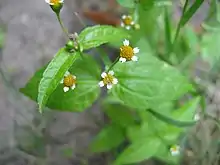Galinsoga parviflora
Galinsoga parviflora[4] is a herbaceous plant in the Asteraceae (daisy) family. It has several common names including guasca (Colombia), pacpa yuyo, paco yuyo, and waskha (Peru), burrionera (Ecuador), albahaca silvestre and saetilla (Argentina), mielcilla (Costa Rica), piojito (Oaxaca, Mexico), galinsoga (New Zealand), gallant soldier,[5][6] quickweed,[6] and potato weed (United Kingdom, United States).
| Galinsoga parviflora | |
|---|---|
 | |
| Scientific classification | |
| Kingdom: | Plantae |
| Clade: | Tracheophytes |
| Clade: | Angiosperms |
| Clade: | Eudicots |
| Clade: | Asterids |
| Order: | Asterales |
| Family: | Asteraceae |
| Genus: | Galinsoga |
| Species: | G. parviflora |
| Binomial name | |
| Galinsoga parviflora Cav. 1796 | |
| Synonyms[1][2][3] | |
|
Species synonymy
| |
History
Galinsoga parviflora was brought from Peru to Kew Gardens in 1796, and later escaped to the wild in Great Britain and Ireland, being temporarily known as the 'Kew Weed'.[7] The plant is named after the Spanish botanist Ignacio Mariano Martinez de Galinsoga. The species name 'parviflora' translates to 'having small flowers'.[8] In Britain, its name Galinsoga is sometimes popularly rendered as "gallant soldiers", and then sometimes altered to "soldiers of the Queen". In Malawi, where the plant is naturalised, it is known as 'Mwamuna aligone' which translates to 'My husband is sleeping'.[7]
Description
Galinsoga parviflora grows to a height of 75 cm (30 in). It is a branched herb with opposite stalked leaves, toothed at the margins. The flowers are in small heads. The 3–8 white ray-florets are about 10 mm (1⁄2 in) long and 3-lobed. The central disc florets are yellow and tubular.[9][10]
Distribution
The species is native to South America; however, it is widely naturalized in other countries.[11][12] There are a few records of G. parviflora and G. quadriradiata in Northern Ireland.[13] It has been naturalized elsewhere, including North America and Australasia.[14][10][15][16]
Uses
In Colombia it is used as a herb in the soup ajiaco.[1] It can also be used as an ingredient in leaf salads, although its subtle flavour, reminiscent of artichoke, mostly develops after being cooked. In eastern Africa, the plant is collected from the wild, and its leaves, stem and flowers eaten. It is also dried and ground into powder for use in soups.[17]
Phytochemicals
In G. parviflora, the major phytochemicals are phenolic acids, depsides and flavonoids with their corresponding glycosides.[18] The flavonoids present are patulitrin, quercimeritrin, quercetagetin, luteolin 7-β-D-glucopyranoside, apigenin 7-β-D-glucoside, galinsoside A, galinsoside B, 7,3’,4’-trihydroxyflavanone and 3,5,7,3’,4’-pentahydroxyflavanone. Phenolic acids and depsides includes vanillic acid, isovanillic acid, p-coumaric acid, p-hydroxybenzoic acid, o-hydroxyphenyl acetic acid, caffeic acid, chlorogenic acid and caffeoylglucaric acids.[18][19][20]
References
- B & T World Seeds, Tridax parviflora (Galinsoga parviflora) in Profile includes photo plus recipe for soup containing this plant as an ingredient
- Tropicos, Galinsoga parviflora Cav.
- The Plant List, Galinsoga parviflora Cav.
- Royal New Zealand Institute of Horticulture – Horticulture Pages – Weeds – Index of names
- BSBI List 2007 (xls). Botanical Society of Britain and Ireland. Archived from the original (xls) on 2015-06-26. Retrieved 2014-10-17.
- USDA, NRCS (n.d.). "Galinsoga parviflora". The PLANTS Database (plants.usda.gov). Greensboro, North Carolina: National Plant Data Team. Retrieved 19 January 2016.
- Mabey, Richard; Lovett Jones, Gareth; Gibbons, Bob (1996). Flora Britannica : supported by common ground. Chatto & Windus. ISBN 1856193772. OCLC 805221553.
- Gordon, Sue (2007-01-01). Plant names explained : botanical terms and their meaning. David & Charles. ISBN 9780715321881. OCLC 471017850.
- Clapham, A.R., Tutin, T.G. and Warburg, E.F. 1968 Excursion Flora of the British Isles. Cambridge University Press. ISBN 0-521-04656-4
- Flora of China, Galinsoga parviflora Cavanilles, 1795. 牛膝菊 niu xi ju
- "Galinsoga parviflora (Gallant-soldier) | Online Atlas of the British and Irish Flora". www.brc.ac.uk. Retrieved 2017-05-16.
- "Galinsoga parviflora (Gallant soldier)".
- Hackney, P. (Ed.) 1992. Stewart & Corry's Flora of the North-east of Ireland. Third Edition. ISBN 0-85389-446-9
- Flora of North America, Galinsoga parviflora Cavanilles, 1795.
- Atlas of Living Australia
- Altervista Flora Italiana, Galinsoga parviflora Cav. includes photos, European distribution map
- Pieroni, Andrea (2005). Prance, Ghillean; Nesbitt, Mark (eds.). The Cultural History of Plants. Routledge. p. 31. ISBN 0415927463.
- Skarupova, Denisa; Vostalova, Jitka; Rajnochova Svobodova, Alena (2020-03-26). "Ultraviolet A protective potential of plant extracts and phytochemicals". Biomedical Papers. 164 (1): 1–22. doi:10.5507/bp.2020.010. PMID 32188958.
- Parzonko, Andrzej; Kiss, Anna K. (17 Dec 2018). "Caffeic acid derivatives isolated from Galinsoga parviflora herb protected human dermal fibroblasts from UVA-radiation". Phytomedicine: International Journal of Phytotherapy and Phytopharmacology. 57: 215–222. doi:10.1016/j.phymed.2018.12.022. ISSN 1618-095X. PMID 30785017. S2CID 73505361.
- Studzińska-Sroka, Elżbieta; Dudek-Makuch, Marlena; Chanaj-Kaczmarek, Justyna; Czepulis, Natasza; Korybalska, Katarzyna; Rutkowski, Rafał; Łuczak, Joanna; Grabowska, Karolina; Bylka, Wiesława; Witowski, Janusz (24 August 2018). "Anti-inflammatory Activity and Phytochemical Profile of Galinsoga Parviflora Cav". Molecules. 23 (9): 2133. doi:10.3390/molecules23092133. ISSN 1420-3049. PMC 6225198. PMID 30149540.
External links
- Dressler, S.; Schmidt, M. & Zizka, G. (2014). "Galinsoga parviflora". African plants – a Photo Guide. Frankfurt/Main: Forschungsinstitut Senckenberg.
- Photo of herbarium specimen at Missouri Botanical Garden, collected in Brazil in 1987
- Photo of herbarium specimen at Missouri Botanical Garden, collected in Dominican Republic in 2006
 Media related to Galinsoga parviflora at Wikimedia Commons
Media related to Galinsoga parviflora at Wikimedia Commons
